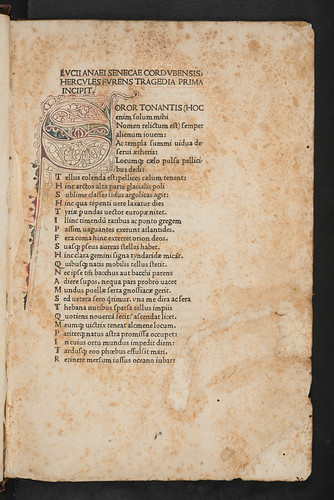Seneca, Lucius Annaeus: Tragoediae.
[Ferrara]: Andreas Belfortis, Gallus, [between 30 Sept. and 17 Dec. 1478]
Fol. a-b10 d8 dd10 e8 f-h10 i-k8 l10 m-n8 o10 p6 q10 r-t8 u6. [174] leaves.
ISTC is00433000; GW M41425; Goff S433; BMC VI 603 (IB. 25621); Bod-inc S-145; CIBN S-200; BSB-Ink S-270.
Printed signatures begin with n3, prior to that they are stamped by hand in extreme lower right-hand corner.
“The partnership formed with the bookseller Pellegrino Sillano on 30 September 1478 for printing the book in 500 copies was dissolved on 17 December: E. Peverada in 'Analecta Pomposiana', 19 (1994), p.183. The historical event alluded to in the colophon is therefore not the Peace of Bagnolo concluded in September 1484 (as BMC, etc.)” - ISTC.
| GIP number: | S26 |
| Shelf-mark: | Sp Coll Hunterian Be.2.11 (see main library entry for this item) |
| Provenance: | Edward Harley (1689-1741), Lord Harley; from 1724 2nd Earl of Oxford: possible owner; see Binding. Thomas Osborne (d.1767), bookseller: possibly no. 925 in ‘Catalogus bibliothecae Harleianae’, III (1744). Anonymous auction sale: lot 986 in 'A catalogue of a scarce collection of books, in English, French and Italian, being part of a well known library' (London: Baker & Leigh, 29 April [1771?]). William Hunter (1718-1783), physician and anatomist: purchased by Hunter at the above anonymous auction for £6.6.0 according to the annotated BL copy of the sale catalogue - shelfmark S.C.S. 12(2). University of Glasgow: Hunterian bequest 1807; Hunterian Museum bookplate on front pastedown, with former shelfmark “Aw.1.8”. |
| Binding: | England, 18th-century gold-tooled red goatskin, possibly bound for Lord Harley by an unidentified binder. On both covers triple fillets form two concentric frames: within the outer frame is an ornamental roll composed of arabesques and three ornaments (including a fleur-de-lys and a flower on a stem), and within the inner frame is a floral roll – neither roll is reproduced in Nixon ‘Harleian bindings’. Each cover has a lozenge-shaped centre-piece, made up of several individual tools; gold-tooled spine, with head and foot of spine decorated with a roll composed of flower heads within a circle alternating with a fern; edges and turn-ins decorated with the same roll. A few of the tools used show similarities with the Chapman, Elliott, and Jane Steel tools illustrated in Nixon, ‘Harleian bindings’, plates 10, 14 & 15, but none appears to be identical. Marbled endpapers. Size: 320 × 220 mm. |
| Leaf size: | 306 x 206 mm. |
| Annotations: | Names of characters added in crimson ink in an early hand in “Thyestes” (quire d and dd); textual correction on a9r; marginal annotation in an early hand on f8v; printed signatures repeated in manuscript in an early hand; quire numbered in an early hand in lower outer corner of first recto leaf “14”-“33” (the numbering of quire a and b partially cropped) - suggesting that this work was once bound with one or more other works. |
| Decoration: | Eight-line initial “S” on a1r supplied in faded blue and crimson with reserved white, and embellished with blue and crimson pen-work which extends into the inner margin; other initials throughout supplied in dark blue or crimson (sometimes with reserved white and sometimes with marginal flourishes); capital strokes in crimson on a1r, a9r and a10v. |
| Imperfections: | None. |





